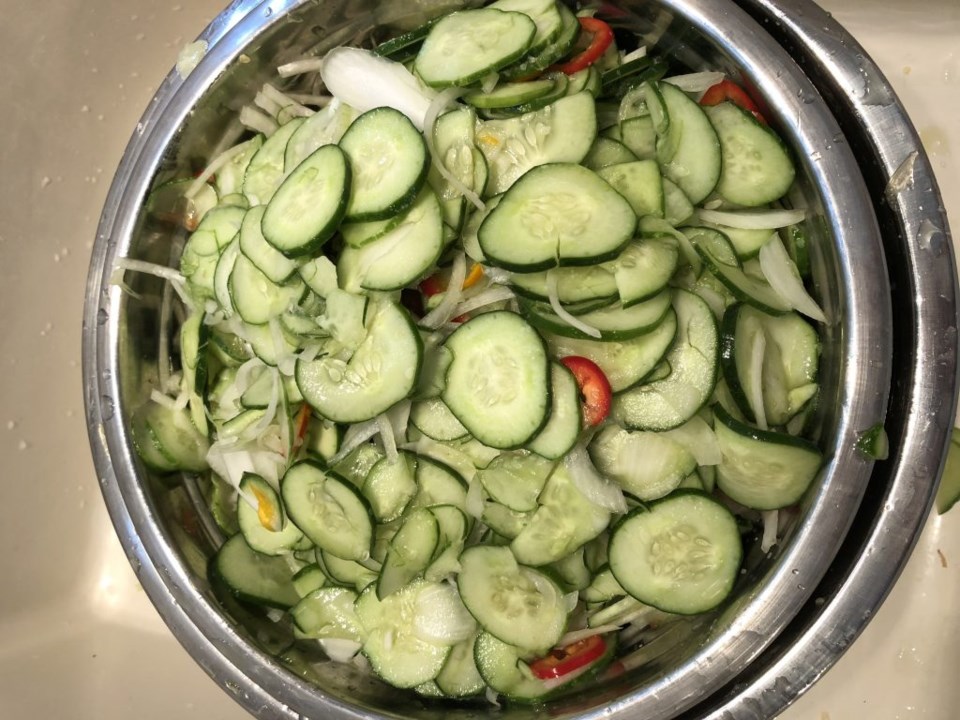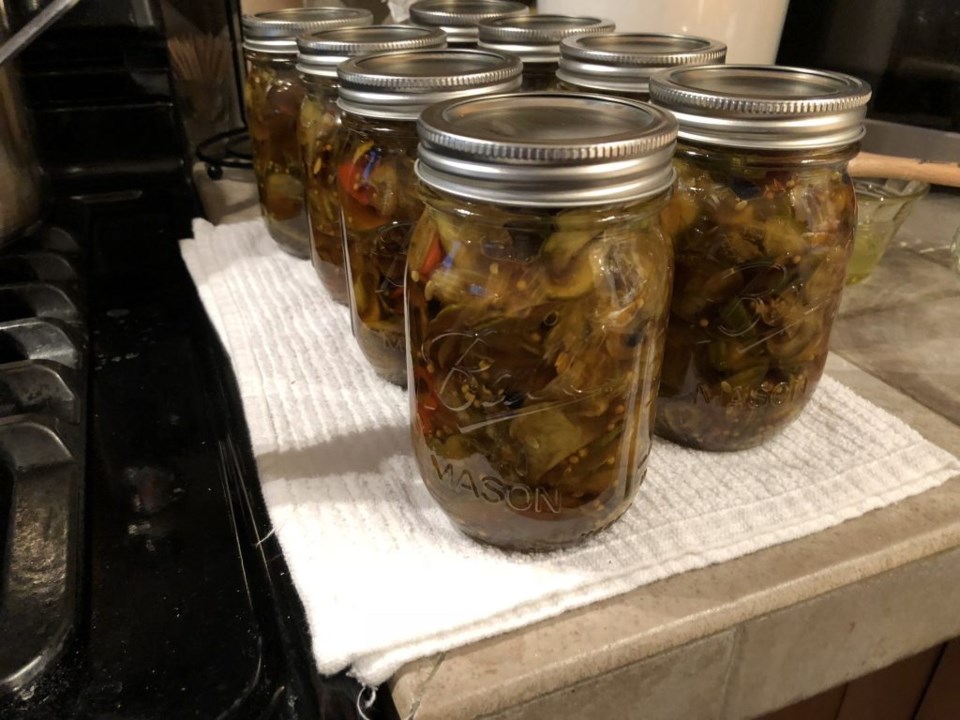This content was originally published by the Longmont Observer and is licensed under a Creative Commons license.
You know you are at the right table at the Saturday Longmont Farmers Market when you are shopping for cucumbers for pickles and notice that the guy in front of you is buying 8 cases for the Boulder Pickling Co. Those preordered cukes were stacked by the side of the truck and his negotiation with the farmers from Blue Sky Farms took less than a minute—less time than it took for me to hand pick my half-peck basket of 4-inch cucumbers, all $10’s worth.
The tropical vines of the Cucurbita family of fruits and vegetables are at their high point right now, including melons, cucumber, squash and the slowly swelling pumpkins
Sensing their soon demise at the first frost, these plants replicate at an astonishing rate. Last Saturday at Miller Farms they were giving away a free cantaloupe with each $10 bag of vegetables sold. All that goodness can’t be consumed at one sitting so we must preserve it somehow. Maybe not the melon branch of the family, but certainly their cousins, those little Kirby cucumbers, and turn them into piquant bread and butter pickles.
From our current culinary perspective, “pickle” is a general term for fruits or vegetables preserved in vinegar or brine, usually with spices, sugar, or both. In Indian and Asian cuisine, pickles are often fiery side dishes that are eaten, fresh or preserved, as condiments. Many vegetables can be pickled—beets, cauliflower, olives, onions, mushrooms, peppers, cabbage, corn, tomato, zucchini, green beans—but here in the US cucumbers are most typical.
Before the invention of refrigeration, pickles of various types served as a sort of winter version of a salad though, with the inevitable amounts of salt and sugar that are necessary to preserve the vegetable, they are of limited nutritional value. You don’t really eat them as a part of your 9 to 11 servings of fruits or vegetables a day, rather just to add a high note to a sandwich or snack.
Brined pickles, like Kosher dills, are cured in a water and salt solution for several weeks and undergo a lactic acid fermentation. The controlled temperature and conditions that this method requires makes it difficult for home cooks. Fresh-pack pickles are treated with salt for several hours to extract the water and then are rinsed, drained and preserved with vinegar. Mixed pickles or relishes include piccalilli, chowchow, mustard pickles and chutneys which are often made with fruit.

Fresh cucumbers are best enjoyed in the summer, when they are available locally and not waxed for preservation. The expression “cool as a cucumber” is based on the fact that the interior temperature of a cucumber can be up to 20º F cooler than the outside air.
Cucumbers are about 96% water and have been used as thirst quenchers since ancient times. They originated in Asia and Africa where they have been cultivated for more than 3,000 years and account for many savory side salads in Middle Eastern, Greek and Indian cuisine.
There are three basic types of cucumbers; the field grown slicing or table cukes which have small white spines on the skin, the smaller pickling varieties from the tiny gherkin to the larger Kirby, which are also field grown, and the greenhouse varieties adapted to culture under artificial light and bred to be nearly seedless, like the long thin English or European cucumbers that come shrink-wrapped in plastic. There are other categories, including the oval-shaped lemon cucumber, as well as Persian and Japanese varieties.
Cucumbers are low in calories at about 45 calories for one 10 to 12-ounce specimen and they contain a fair amount of vitamins A and C. When the fresh grown ones are not available, it is best to peel the waxed varieties and scrape out the seeds with a spoon before slicing.
The following recipe is a variation of the classic bread and butter pickle that substitutes cumin seed for the dill seed and includes heat from some chilies. These make a great accompaniment to barbecued meats of any variety.

Mexican Bread and Butter Pickles
Makes about 4 pints
- 8 cups thinly-sliced Kirby cucumbers
- 1 pound onions, thinly sliced
- One green pepper or a mix of hot peppers to equal one cup, shredded or chopped
- One-fourth cup Kosher salt
- 2 cups brown sugar
- One half teaspoon turmeric
- 4 whole cloves
- 1 tablespoon whole yellow mustard seed
- 1 teaspoon cumin seed
- One half teaspoon coriander seed
- 2 cups cider vinegar
Mix the cucumbers, onions, green pepper, and salt. Cover and let stand in a colander set in a larger bowl at room temperature for 3 hours or overnight in the refrigerator. Mix the remaining ingredients in a large pot and slowly bring to the boiling point. Boil the mixture for 5 minutes. Drain the vegetables in the colander and rinse them very well with cold water. Add them to the hot syrup and heat to just below the boiling point (about 200º F).
Spoon into hot, sterilized jars*, fill with the hot cucumber mixture and leave a headspace of about one-eighth inch. Top with new jar lids and seal, then process in a boiling water bath for 10 minutes.
To be certain that the jar is sealed for long-term storage, listen for the lids to pop when a vacuum is created in the jar. You will not be able to press down the center of the lid. If any jars do not seal properly, store them in the refrigerator and use them first. The flavor of pickled produce is improved after 6 weeks of storage.
*To sterilize the jars, wash them in hot soapy water, rinse, and then place them in a large pot of boiling water to cover. Alternatively, you can run them in the dishwasher and fill them just when the cycle stops and they are still hot.


